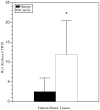Redox imbalance and biochemical changes in cancer
- PMID: 23878188
- PMCID: PMC3800221
- DOI: 10.1158/0008-5472.CAN-13-1117
Redox imbalance and biochemical changes in cancer
Abstract
For this article, we explore a hypothesis involving the possible role of reduction/oxidation (redox) state in cancer. We hypothesize that many modifications in cellular macromolecules, observed in cancer progression, may be caused by redox imbalance. Recent biochemical data suggest that human prostate cancer cell lines show a redox imbalance (oxidizing) compared with benign primary prostate epithelial cells; the degree of oxidation varied with aggressive behavior of each cell line. Our recent data suggest that human breast cancer tissues show a redox imbalance (reducing) compared with benign adjacent breast tissues. Accumulating data summarized in this article suggest that redox imbalance may regulate gene expression and alter protein stability by posttranslational modifications, in turn modulating existing cellular programs. Despite significant improvements in cancer therapeutics, resistance occurs, and redox imbalance may play a role in this process. Studies show that some cancer therapeutic agents increase generation of reactive oxygen/nitrogen species and antioxidant enzymes, which may alter total antioxidant capacity, cause cellular adaptation, and result in reduced effectiveness of treatment modalities. Approaches involving modulations of intra- and extracellular redox states, in combination with other therapies, may lead to new treatment options, especially for patients who are resistant to standard treatments.
©2013 AACR.
Figures


Similar articles
-
Nanomaterials-Induced Redox Imbalance: Challenged and Opportunities for Nanomaterials in Cancer Therapy.Adv Sci (Weinh). 2024 Apr;11(16):e2308632. doi: 10.1002/advs.202308632. Epub 2024 Feb 21. Adv Sci (Weinh). 2024. PMID: 38380505 Free PMC article. Review.
-
Reactive Oxygen and Nitrogen Species-Induced Protein Modifications: Implication in Carcinogenesis and Anticancer Therapy.Cancer Res. 2018 Nov 1;78(21):6040-6047. doi: 10.1158/0008-5472.CAN-18-0980. Epub 2018 Oct 16. Cancer Res. 2018. PMID: 30327380 Review.
-
Programmed cell death, redox imbalance, and cancer therapeutics.Apoptosis. 2021 Aug;26(7-8):385-414. doi: 10.1007/s10495-021-01682-0. Epub 2021 Jul 8. Apoptosis. 2021. PMID: 34236569 Review.
-
The variable chemotherapeutic response of Malabaricone-A in leukemic and solid tumor cell lines depends on the degree of redox imbalance.Phytomedicine. 2015 Jul 15;22(7-8):713-23. doi: 10.1016/j.phymed.2015.05.007. Epub 2015 May 29. Phytomedicine. 2015. PMID: 26141757
-
The redox regulation of thiol dependent signaling pathways in cancer.Curr Pharm Des. 2006;12(34):4427-43. doi: 10.2174/138161206779010549. Curr Pharm Des. 2006. PMID: 17168752 Review.
Cited by
-
Cold Atmospheric Plasma: Possible Cure of Autoimmune Disorders and Cancer via Attenuating Inflammation.Int J Biol Sci. 2024 Oct 7;20(14):5436-5449. doi: 10.7150/ijbs.102445. eCollection 2024. Int J Biol Sci. 2024. PMID: 39494336 Free PMC article. Review.
-
The mitochondrial and endoplasmic reticulum pathways involved in the apoptosis of bursa of Fabricius cells in broilers exposed to dietary aflatoxin B1.Oncotarget. 2016 Oct 4;7(40):65295-65306. doi: 10.18632/oncotarget.11321. Oncotarget. 2016. PMID: 27542244 Free PMC article.
-
Dual-Mode Tumor Imaging Using Probes That Are Responsive to Hypoxia-Induced Pathological Conditions.Biosensors (Basel). 2022 Jun 30;12(7):478. doi: 10.3390/bios12070478. Biosensors (Basel). 2022. PMID: 35884281 Free PMC article. Review.
-
Reactive oxygen species in normal and tumor stem cells.Adv Cancer Res. 2014;122:1-67. doi: 10.1016/B978-0-12-420117-0.00001-3. Adv Cancer Res. 2014. PMID: 24974178 Free PMC article.
-
Metformin induces an intracellular reductive state that protects oesophageal squamous cell carcinoma cells against cisplatin but not copper-bis(thiosemicarbazones).BMC Cancer. 2014 May 5;14:314. doi: 10.1186/1471-2407-14-314. BMC Cancer. 2014. PMID: 24886082 Free PMC article.
References
-
- Hussain SP, Hofseth LJ, Harris CC. Radical causes of cancer. Nat Rev Cancer. 2003;3(4):276–85. 04//print. - PubMed
-
- Zhang DD. The Nrf2-Keap1-ARE signaling pathway: The regulation and dual function of Nrf2 in cancer. Antioxidants & redox signaling. 2010 Dec 1;13(11):1623–6. Epub 2010/05/22. eng. - PubMed
-
- Bakalova R, Zhelev Z, Aoki I, Saga T. Tissue redox activity as a hallmark of carcinogenesis: from early to terminal stages of cancer. Clinical cancer research : an official journal of the American Association for Cancer Research. 2013 May 1;19(9):2503–17. Epub 2013/03/28. eng. - PubMed
Publication types
MeSH terms
Grants and funding
LinkOut - more resources
Full Text Sources
Other Literature Sources

